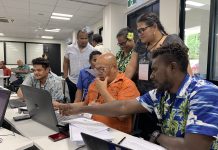The theme for World Cancer Day this year is “Closing the Care Gap”. It is the same theme as last year, and indeed will be the same theme in 2024, in recognition of the deep-rooted inequities that populations face in receiving cancer care within countries, and between countries.
A blog by Emily Gilmour, Health Officer, Commonwealth Secretariat
Unfortunately, in the Commonwealth, we know these inequities all too well. With the Commonwealth carrying a 40 percent share of the global cervical cancer incidence burden, and 43 percent of the global mortality burden, the case for action has never been clearer.
Over the last several years, the Commonwealth has taken steps to address the burden of cervical cancer. In the Commonwealth Heads of Government meeting last year, Heads recognised that cervical cancer is still the most common cancer affecting women in many Commonwealth countries and resolved to accelerate the elimination of cervical cancer as a public health problem.
As a first step, Heads of Government made a landmark commitment to ensure all girls by age 13 have access to the human papillomavirus vaccine by 2025.
And beyond high-level commitments, progress has been made on cervical cancer. Whilst progress must move much faster if we are to achieve our collective commitments, it is important to reflect on some of the countries that have continued to lead the way in reducing the incidence and mortality rates of cervical cancer in the Commonwealth.
Taking action to implement HPV vaccination programmes
Over the years, Commonwealth countries have historically broken new ground on preventative measures to address cervical cancer. In 2011, Rwanda became the first African country to introduce a national HPV vaccination campaign for all girls between the ages of 11 and 15, with coverage now standing at over 90 percent.
In 2010, Malaysia became the first Asian country to roll out a national HPV vaccination programme. And Australia, through its efforts in prevention interventions, is poised to be the first country to eliminate the disease.
Latest available data from 2019 shows that 34 Commonwealth countries have a HPV vaccination programme included within its national immunisation schedule, which is up from 32 in 2017 and 29 in 2015. When WHO’s data gets updated, we can expect to see the number rise, with countries including Sierra Leone, which introduced the vaccine to the routine immunisation schedule in October 2022.
Undoubtedly, this is progress. But with the Commonwealth 2025 commitment on HPV vaccines fast approaching, we must continue to increase the number of countries with HPV vaccines in the national routine immunisation schedule.
Advancing low-cost HPV vaccines in India and beyond
Another significant advance was made by India, which in late 2022 launched its first locally produced version of the human papillomavirus (HPV) vaccine. Developed jointly by the Serum Institute of India and the Indian Government’s Department of Biotechnology, the quadrivalent Cervavac vaccine offers protection against virus strains most likely to cause cancer of the cervix, vagina and vulva, among others.
At just 200-400 rupees (US$5) per dose, the vaccine is considerably lower in cost than other vaccines, with some of the most widely used alternatives costing between US$262 and $360 for three doses.
With 99 percent of cervical cancer cases being caused by high-risk HPV infection, the creation of a more affordable vaccine offers a significant step forward in addressing the inequitable burden of cervical cancer. The launch of this vaccine will hopefully help India, which has a high incidence of cervical cancer, and other Commonwealth nations to achieve our collective commitment.
In 2016, the Sylvia Bongo Ondimba Foundation’s cancer treatment centre, La Maison D’Alice, or Alice House, opened its doors. Whilst cancer treatment is free of charge in Gabon, for a patient who comes from the country’s interior, there are additional costs for transport, accommodation, and food, which often unaffordable for patients.
The Centre therefore provides accommodation and catering for the patient and one companion, to facilitate a greater access to treatment and reducing the number of people stopping treatment. As part of their care, the Centre provides holistic support including a psychologist and social worker to support each patient, art therapy sessions and physiotherapy sessions.
Since 2016, Alice House has welcomed 307 patients, and has contributed to ensuring that more women in Gabon have access to the cancer care they need.
Our hope for a cervical cancer-free future
As we recognise the advances that have been achieved so far, it is important to note that there is still a significantly long way to go before the goal of elimination in the Commonwealth is achieved.
Many Commonwealth countries still do not have national cervical cancer prevention and screening programmes. Communities continue to face inequities of access to cervical cancer services. And many women do not have accurate, relevant and quality information on HPV and cervical cancer available to them and are burdened by the cost to receive cancer care.
Should we aspire for a future that is free from cervical cancer, we must remain united in addressing the wide inequities women across the Commonwealth experience in accessing cervical cancer prevention, screening and treatment services.
SOURCE: COMSEC/PACNEWS


















